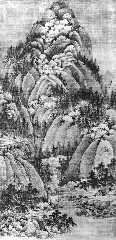 Although there was the chaos of wars and many dynastic changes during the Five Dynasties and Ten Kingdoms Period (907-979), painting was still developing on the basis of previous dynasties. Paintings of figure, mountain-and-water and flower-and-bird, reached a new peak during this short and warring period.
Although there was the chaos of wars and many dynastic changes during the Five Dynasties and Ten Kingdoms Period (907-979), painting was still developing on the basis of previous dynasties. Paintings of figure, mountain-and-water and flower-and-bird, reached a new peak during this short and warring period.
Wars in the Central Plains did not stop the production of paintings. More topics were absorbed into figure painting in the Five Dynasties, such as religious stories, historical stories and scholar's life. A large number of painters emphasized on describing the expression and inner world of figures, thus the artistic level of true-to-life portrayal scaled a new height. The techniques and style followed two directions: as to meticulous painting (gongbi hua), its strokes and colors were more varied than those of the Tang Dynasty; as to the ink and wash, great freehand-brushwork emerged. Landscape painting achieved prominent progress in this period. Its subject and technique developed in leaps and bounds. Landscape was treated as a form of environmental art. The appearance of Jing, Guan, Dong, Ju schools and the Four Great Masters became the milestone of the history of Chinese landscape painting.There emerged two completely different styles of landscape painting -- Jing Hao and Guan Tong, representing the northern school; Dong Yuan and Ju Ran, the southern school. The northern school pursued a panoramic structure and spectacular when painting, while the southern school focused on the morbidezza of mountains and waters in southernChina. It was on the basis of techniques used by Dong Yuan and Ju Ran, that Mi Youren, the best-know scholar painter in the Song Dynasty (960-1279), created ink-and-wash painting.Light-ink stroke, an important skill of Chinese landscape painting, also developed greatly. The way of using ink gradually became abundant. After long period of development, ink and wash landscape painting was mature.
 The two painting contradictory styles aroused the scholars' interest in other artistic fields like poem, article and calligraphy.Sikong Tu(poet in the Tang Dynasty), Yan Yu (poetry critics in the Song Dynsaty), Xu Wei (painter and calligraphy in the Ming Dynasty) and Hu Yinglin (writer in the Ming Dynasty) had close relationship with the southern school of landscape painting. They exerted a significant influence in the 300 years of the Qing Dynasty (1644-1911).
The two painting contradictory styles aroused the scholars' interest in other artistic fields like poem, article and calligraphy.Sikong Tu(poet in the Tang Dynasty), Yan Yu (poetry critics in the Song Dynsaty), Xu Wei (painter and calligraphy in the Ming Dynasty) and Hu Yinglin (writer in the Ming Dynasty) had close relationship with the southern school of landscape painting. They exerted a significant influence in the 300 years of the Qing Dynasty (1644-1911).
